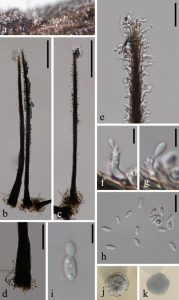Phaeoisaria clematidis (Fuckel) S. Hughes, Can. J. Bot. 36: 794 (1958)
Index Fungorum number: IF 302703
Saprobic on submerged wood. Asexual morph: Colonies effuse, scattered to gregarious, hairy, brown, covered with bright white conidia. Mycelium partly immersed, partly superficial. Conidiophores 870–900 × 23–28 μm (x̅ = 885 × 25 μm, n = 5), macronematous, synnematous, septate, branched, dark brown to black, paler towards apex, straight or slightly bent, flared at the apex, smooth. Conidiogenous cells holoblastic, polyblastic, integrated, terminal, sympodial, subcylindrical, denticulate, each with several conidiogenous loci, subhyaline. Conidia 6.3–8.7 × 3–4.3 μm (x̅ = 7.8 × 3.5 μm, n = 20), narrowly ellipsoidal, obovoid, rounded at the apex, hyaline, aseptate, straight, smooth-walled. Sexual morph: Undetermined.
Culture characteristics – on PDA, colony circular, reaching 7 mm diam. in 20 days at 25 °C, grey from above, pale grey from below, surface rough, dry, with dense mycelium, raised, undulated edge.
Material examined – China, Yunnan Province, Pingbian, on submerged wood, 20 September 2017, W. Dong, WF-17A-1 (MFLU 18-1176), living culture MFLUCC 18-1017; ibid., WF-17A-2 (HKAS 101709), living culture KUMCC 18-0058.
GenBank numbers – ITS: MW131990, LSU: MW132065, SSU: MW132063.
Known distribution (based on molecular data) – Australia (Réblová et al. 2012), China (Luo et al. 2018, this study)
Known hosts (based on molecular data) – Protea sp. (Réblová et al. 2012)
Notes – Our isolate from freshwater (MFLUCC 18-1017) clusters with four strains of Phaeoisaria clematidis with high bootstrap support (Fig. 61). Phaeoisaria clematidis was initially published in 1958 (Index Fungorum 2020). Réblová et al. (2012) first sequenced P. clematidis isolate collected from Bark of Protea in Australia. Luo et al. (2018) added another two freshwater collections from Lancang River, China, with illustrations and detailed descriptions. Our isolate (MFLUCC 18-1017) has nearly identical morphological characters with the collection of Luo et al. (2018), except for the longer conidiophores (870–900 μm vs 312–568 μm) of isolate MFLUCC 18-1017. Based on morphological and molecular evidence, we identify MFLUCC 18-1017 as P. clematidis.

Phaeoisaria clematidis (MFLU 18-1176, new collection). a Colonies on submerged wood. b–c, e Conidiophores with attached conidia. d The base of conidiophore. f, g Conidiogenous cells with conidia. h Conidia. i Germinated conidium. j, k Colony on PDA (left-front, right-reverse). Scale bars: b, c = 100 μm, d = 50 μm, e = 20 μm, f, g, i = 5 μm, h = 10 μm.
